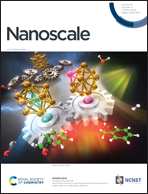Effects of thermal annealing on analog resistive switching behavior in bilayer HfO2/ZnO synaptic devices: the role of ZnO grain boundaries†
Abstract
The effects of thermal annealing on analog resistive switching behavior in bilayer HfO2/ZnO synaptic devices were investigated. The annealed active ZnO layer between the top Pd electrode and the HfO2 layer exhibited electroforming-free resistive switching. In particular, the switching uniformity, stability, and reliability of the synaptic devices were dramatically improved via thermal annealing at 600 °C atomic force microscopy and X-ray diffraction analyses revealed that active ZnO films demonstrated increased grain size upon annealing from 400 °C to 700 °C, whereas the ZnO film thickness and the annealing of the HfO2 layer in bilayer HfO2/ZnO synaptic devices did not profoundly affect the analog switching behavior. The optimized thermal annealing at 600 °C in bilayer HfO2/ZnO synaptic devices dramatically improved the nonlinearity of long-term potentiation/depression properties, the relative coefficient of variation of the asymmetry distribution σ/μ, and the asymmetry ratio, which approached 1. The results offer valuable insights into the implementation of highly robust synaptic devices in neural networks.

- This article is part of the themed collection: Nanoscale and Nanoscale Horizons: Nanodevices


 Please wait while we load your content...
Please wait while we load your content...